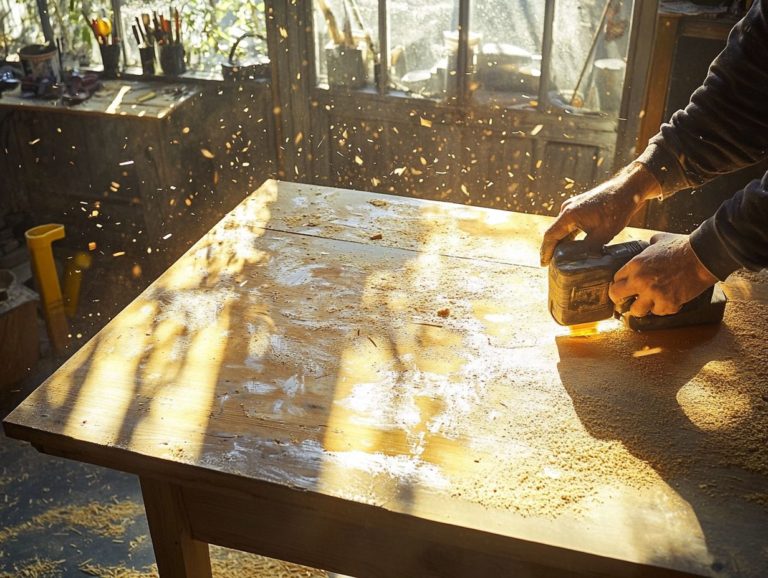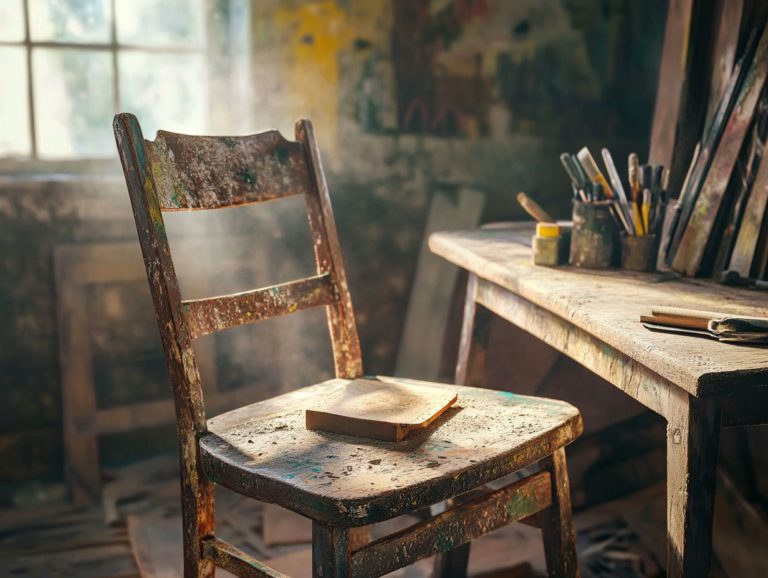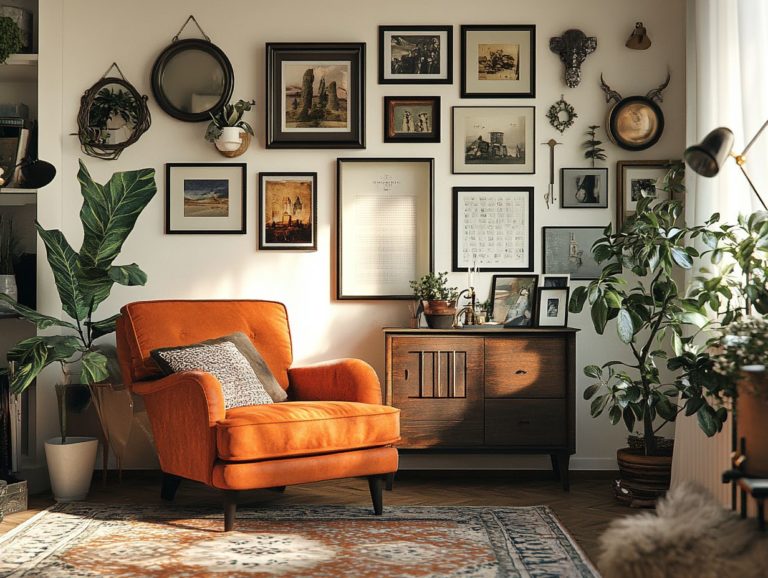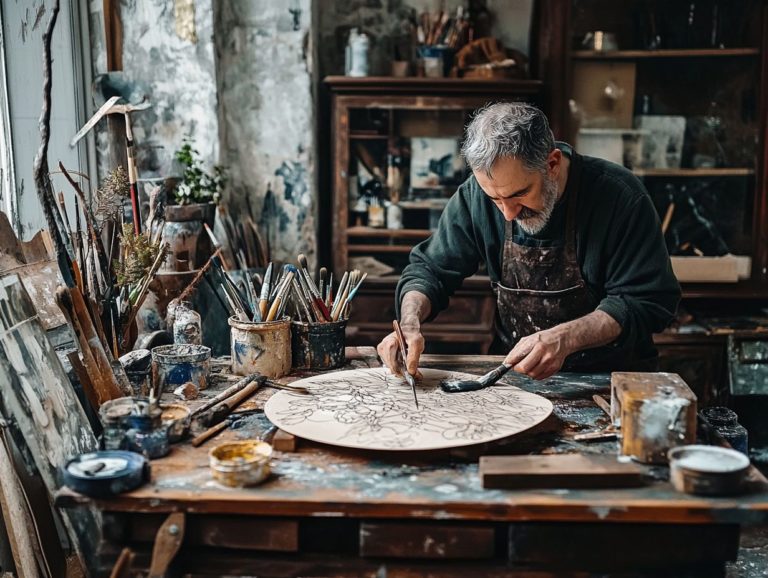How to Restore Vintage Handcrafted Rugs
Vintage handcrafted rugs are not just pretty to look at; they tell captivating stories woven from culture, craftsmanship, and history.
As time passes, these exquisite pieces may show signs of wear that can detract from their beauty.
This guide will help you identify damage, prepare for fixing, and provide a step-by-step process to rejuvenate your cherished rugs.
You will also find valuable tips on maintenance and alternatives if fixing isn t possible.
Uncover the secrets to preserving these unique treasures for future generations!
Contents
- Key Takeaways:
- What Makes Them Special?
- Signs of Wear and Tear
- Preparing for Restoration
- Step-by-Step Restoration Process
- Tips for Maintaining Restored Rugs
- Alternative Options for Damaged Rugs
- Frequently Asked Questions
- What are signs that a vintage handcrafted rug needs restoration?
- Can I restore a vintage handcrafted rug myself?
- How long does it take to restore a vintage handcrafted rug?
- How much does it cost to restore a vintage handcrafted rug?
- Will the restored rug look exactly like the original?
- How can I prevent my vintage handcrafted rug from needing restoration?
Key Takeaways:
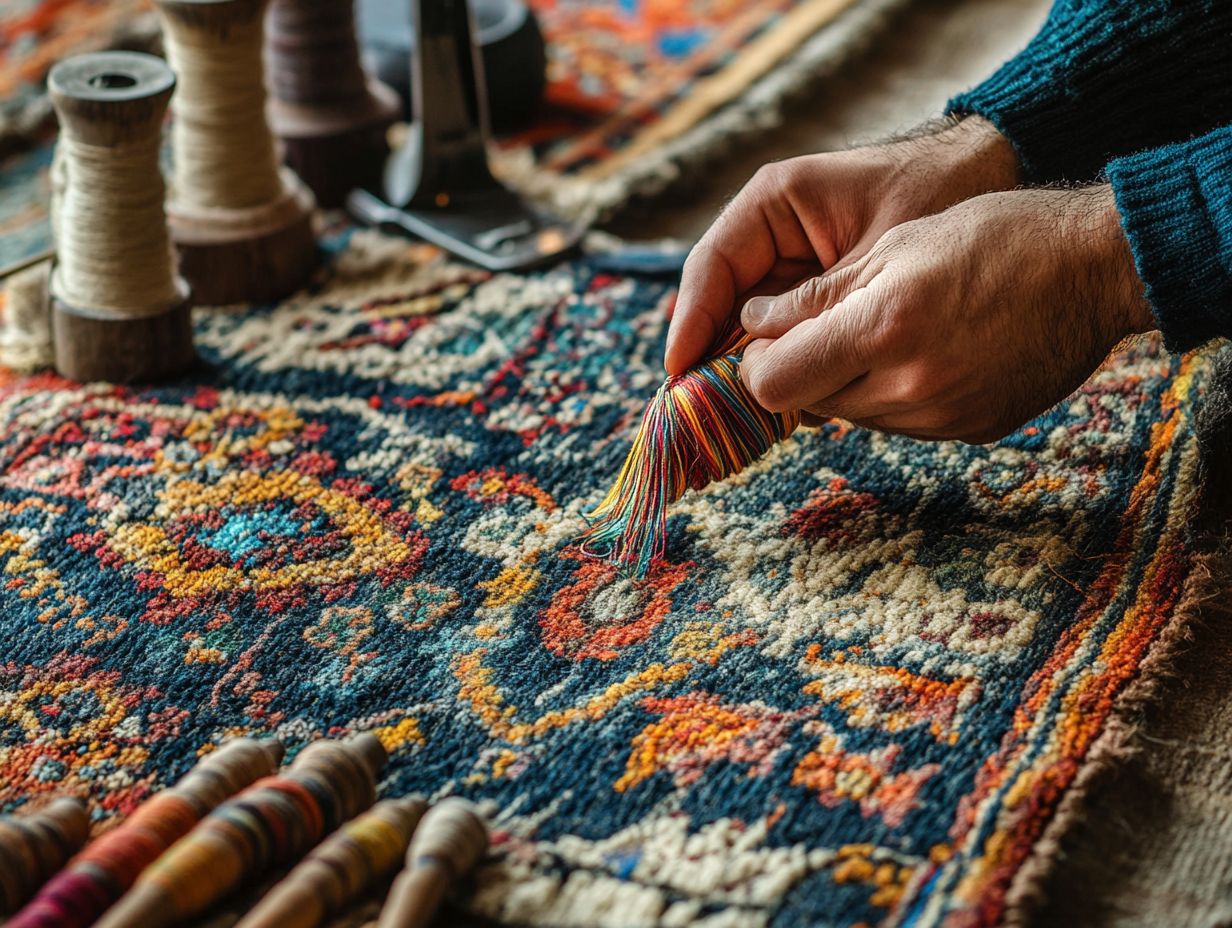
- Properly identifying wear and tear is crucial for determining how to fix vintage handcrafted rugs.
- Gather all necessary materials and tools before starting the fixing process for a smooth outcome.
- Maintaining restored rugs requires proper care and cleaning techniques to preserve their beauty and longevity.
What Makes Them Special?
Rugs, especially vintage and Persian varieties, are more than just decorative pieces; they encapsulate history, culture, and craftsmanship that make them remarkable. Each piece tells a unique story through its intricate patterns, vibrant colors, and the natural fibers woven into its design.
Whether you re looking at area rugs or antique carpets, these treasures often hold sentimental value, making their preservation essential for maintaining their integrity. By understanding what elevates these rugs beyond the ordinary, you can truly appreciate their worth, whether you’ve found a vintage gem on Facebook Marketplace or inherited an heirloom that your family has cherished for generations.
Signs of Wear and Tear
As time goes by, even your most cherished rugs may show signs of wear and tear, which can affect both their integrity and visual appeal. Look for common signs such as faded colors, fraying edges, and other damages that can diminish the rug s overall condition.
Recognizing these signs is essential for effective maintenance. It allows you to determine when professional fixing or cleaning techniques may be necessary. Vintage carpets can be particularly vulnerable due to their age, so it’s vital to regularly check your rugs for any signs of wear and address any issues promptly.
Identifying Damage and Aging
Identifying damage and aging in your rugs is crucial for effective fixing, allowing each piece to retain its charm and value for years. As you inspect for damage caused by moths and assess the weave’s integrity, understanding the factors that contribute to rug aging becomes essential, especially if you own cherished antique or vintage finds.
A thorough rug assessment by a specialist can reveal hidden issues that might not be immediately noticeable, guiding you to seek professional fixing services when necessary.
Professionals take a careful approach to evaluate various signs of wear, such as discoloration, fraying edges, and stains from everyday use. They examine the foundation and pile of the rug, pinpointing areas that may require repair or specialized cleaning techniques. This thorough assessment not only highlights existing problems but also helps predict potential future issues, empowering you to make informed decisions about maintenance and care.
These experts can recommend tailored fixing methods, like dyeing, reweaving, or backing repair, ensuring that the fixing process is perfectly suited to the unique needs of each piece in your collection.
Preparing for Restoration
Preparing for rug restoration requires meticulous planning and the right materials to ensure a successful outcome. You’ll want to select the appropriate cleaning solutions and restoration products while familiarizing yourself with various restoration techniques.
Whether you re dealing with a vintage treasure or a more recent find, it s crucial to maintain the rug s integrity as you embark on the restoration journey. This attention to detail helps preserve its sentimental and aesthetic value.
When you prepare well, professional restoration services work wonders for your rug. It can look beautiful again!
By gathering the necessary materials and tools, you ensure you’re fully equipped to tackle both cleaning and repair tasks with confidence. You’ll want to have effective cleaning agents, specialized restoration products tailored for your specific rug type, and a gentle scrubber to protect those delicate fibers.
Don t underestimate the importance of rug pads; they play a pivotal role in extending your rug’s lifespan and performance on the floor. By thoughtfully selecting these materials, you can significantly elevate the effectiveness of your restoration efforts.
Regarding cleaning agents, choose solutions that won’t harm your rug, like those safe for wool, synthetic, or silk fibers, depending on your rug’s material. A soft-bristle brush or a microfiber cloth is critical for removing dirt without causing any harm.
For repairs, having specialty tools like a needle and rug thread at the ready will empower you to tackle seam work or fringe restoration, while adhesive patches can efficiently handle larger tears.
Local craft stores or online marketplaces are excellent resources for sourcing these tools, providing a variety of options tailored to your specific needs. Employing these cleaning techniques will ensure your rugs look stunning and last longer.
Step-by-Step Restoration Process
You ll be amazed at how beautiful your rug can look again! The step-by-step restoration process involves several crucial phases, from the initial cleaning to detailed repairs, ensuring that each piece receives the utmost care.
Start with a thorough assessment, determining the best cleaning methods based on the rug s material be it wool, silk, or synthetic blends.
After cleaning, the rug may need specific repair techniques to tackle any damage, such as color restoration or fringe replacement. By following these steps carefully, you ll uphold the rug s integrity and aesthetic appeal, often requiring the expertise of professional services to achieve the best results.
Cleaning and Repairing the Rug
Cleaning and repairing your rug is a delicate task that demands a discerning selection of methods and solutions to ensure the fibers remain vibrant for years to come. Depending on the material of your rug be it a vintage wool masterpiece or a delicate silk gem you’ll need to choose your cleaning solutions wisely to achieve efficacy without jeopardizing the rug’s integrity.
After the cleaning phase, you might find that specific repairs are necessary, ranging from minor touch-ups to more extensive restoration efforts, each requiring a gentle touch.
When you’re cleaning a wool rug, remember that gentle washing with mild detergents can help preserve its natural oils and texture. On the other hand, silk rugs call for a more cautious approach, often necessitating professional care to avoid irreversible damage.
Each material thrives under tailored cleaning techniques, and using natural solutions can significantly extend the rug’s lifespan. Understanding repair methods such as knotting for wool rugs or reweaving for damaged silk is essential for maintaining both the aesthetic appeal and structural integrity of your treasured piece.
A thoughtful combination of cleaning and repair will enhance the durability of your rug, ensuring it continues to be a source of beauty in your space.
Recoloring and Replacing Fringes
Recoloring and replacing fringes are essential steps in restoring rugs. These actions can dramatically enhance the piece’s original beauty and vintage charm.
By employing methods to refresh colors, such as re-dyeing with fabric dye, you can revive faded colors. This ensures that the fresh hues harmonize with the rug’s unique patterns.
Fringe replacement is also crucial for preserving the rug’s integrity and aesthetics. It provides a polished finish that honors the design and craftsmanship.
Effective execution of these restoration techniques starts with a careful assessment of the rug’s material and existing dye patterns. This knowledge is key to selecting the most suitable colors and methods.
Opting for eco-friendly dyes not only achieves a stunning visual effect but also promotes the longevity of the fibers. Engaging skilled artisans who appreciate vintage charm is vital. Their expertise ensures that the fringe replacements match the original style in both texture and appearance.
By combining these methodologies, the rug not only regains its former glory but also tells a renewed story that resonates with the warmth of its history.
Tips for Maintaining Restored Rugs
Maintaining restored rugs is crucial for preserving their beauty and longevity. This demands careful attention to specific preservation techniques.
Regular maintenance involves cleaning practices that effectively remove dirt and dust while shielding the rug from UV damage, which can cause colors to fade.
Implement these effective care strategies to ensure that both vintage and antique rugs remain vibrant and intact. This allows them to continue being cherished pieces in your home for years to come!
Proper Care and Cleaning Techniques

Implementing proper care and cleaning techniques is essential for maintaining the beauty and functionality of your restored rugs. This ensures they remain a cherished component of your home decor.
Different rug materials, such as wool, silk, or synthetic fibers, require distinct cleaning approaches. It s crucial to understand the specific needs of each type.
For example, wool rugs respond well to a mild detergent mixed with water. It s vital to apply a gentle touch to avoid damaging those delicate fibers.
For silk, opting for a specialized cleaner is wise, as harsh agents can lead to unsightly discoloration. Utilizing proper cleaning tools like soft brushes and lint-free cloths can significantly minimize the risk of wear.
Integrating quality rug pads not only protects your rugs from sliding or curling but also absorbs impact. This ensures their beauty is preserved for years to come.
Alternative Options for Damaged Rugs
When you encounter damaged rugs, consider exploring alternative options like repurposing or replacing them to preserve their unique vintage beauty.
While some rugs may demand intensive restoration techniques, others could be perfectly suited for creative repurposing into charming home decor items, such as wall hangings or cushion covers.
If repair isn t a feasible option, selecting a replacement rug with a similar design can help maintain the aesthetic appeal of your space. This ensures your environment remains as captivating as ever.
Considering Repurposing or Replacing
Deciding whether to repurpose or replace a damaged rug balances creativity with practicality. You want to keep the vintage charm you love while making the best choice.
Repurposing can breathe new life into your beloved piece. You can transform it into chic cushion covers or a distinctive wall tapestry.
These options allow you to weave in stories from its past, giving it new life and function. Replacing the rug, however, lets you explore contemporary designs that elevate your space.
Remember, replacement can come with a hefty price tag, especially for quality craftsmanship.
This choice affects not just the look but also the comfort and warmth that a treasured vintage rug provides.
Frequently Asked Questions
What are signs that a vintage handcrafted rug needs restoration?
Look for signs like fading, frayed edges, holes, or missing fibers.
Can I restore a vintage handcrafted rug myself?
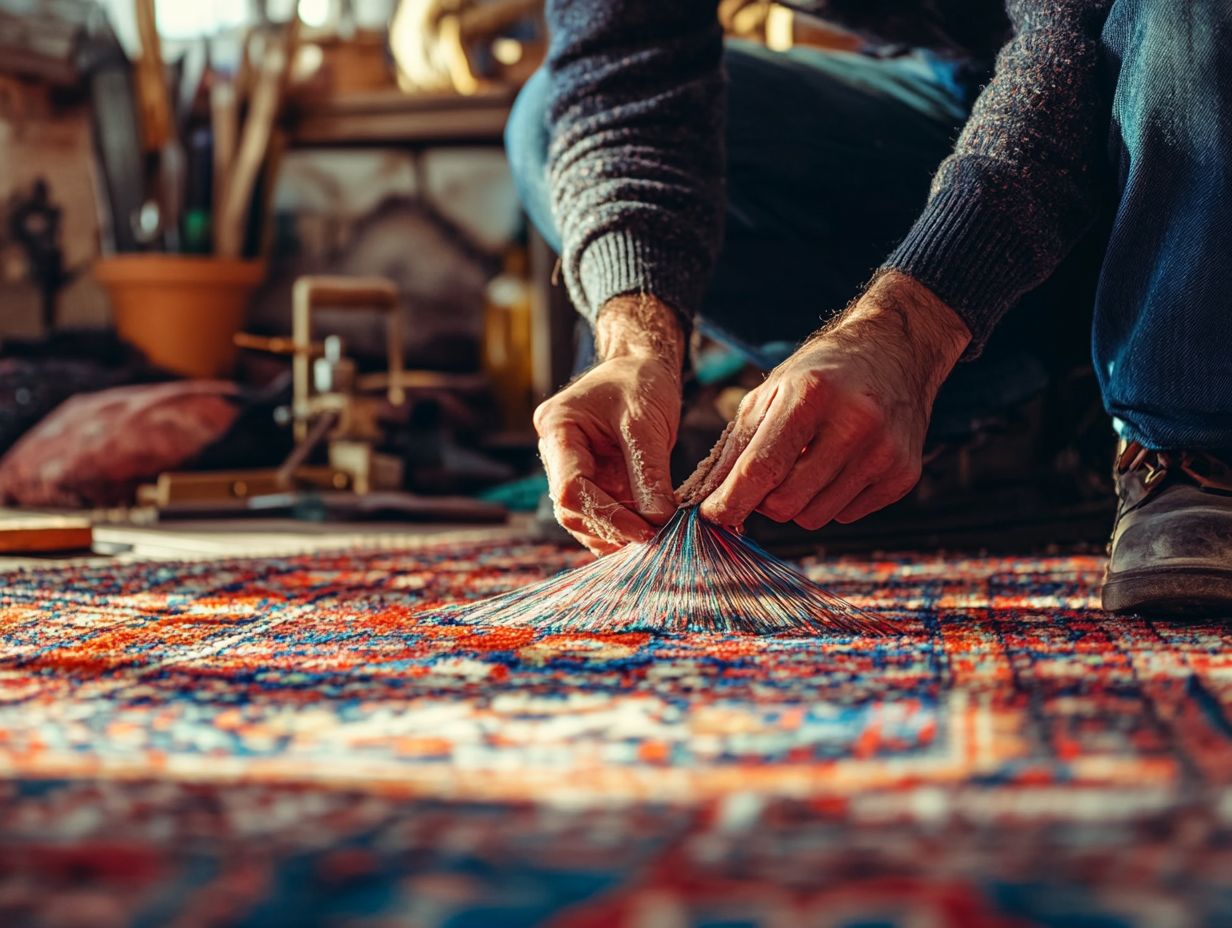
It’s best to leave it to the experts for stunning results!
How long does it take to restore a vintage handcrafted rug?
The time varies based on damage level and restoration complexity. It can take from a few days to weeks.
How much does it cost to restore a vintage handcrafted rug?
The cost varies by rug size and damage extent. Always get a quote from a professional service.
Will the restored rug look exactly like the original?
The aim is to preserve the rug’s original look and integrity. Minor differences may occur due to the restoration process.
How can I prevent my vintage handcrafted rug from needing restoration?
Regularly clean and rotate the rug. Avoid placing heavy furniture on it and keep it away from direct sunlight and moisture.

